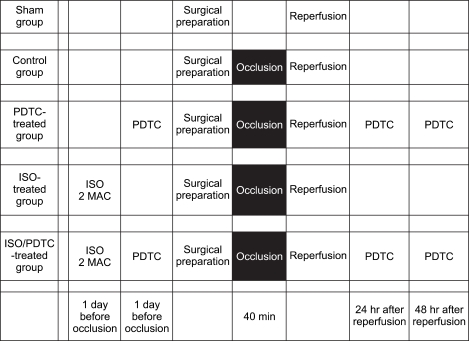1. Kwon BK, Tetzlaff W, Grauer JN, Beiner J, Vaccaro AR. Pathophysiology and pharmacologic treatment of acute spinal cord injury. Spine J. 2004; 4:451–464. PMID:
15246307.

2. Kumagai H, Isaka M, Sugawara Y, Okada K, Imai K, Orihashi K, et al. Intra-aortic injection of propofol prevents spinal cord injury during aortic surgery. Eur J Cardiothorac Surg. 2006; 29:714–719. PMID:
16522369.

3. Wakeno-Takahashi M, Otani H, Nakao S, Imamura H, Shingu K. Isoflurane induces second window of preconditioning through upregulation of inducible nitric oxide synthase in rat heart. Am J Physiol Heart Circ Physiol. 2005; 289:H2585–H2591. PMID:
16006547.

4. Bolli R. The early and late phases of preconditioning against myocardial stunning and the essential role of oxyradicals in the late phase: an overview. Basic Res Cardiol. 1996; 91(1):57–63. PMID:
8660262.

5. Zheng S, Zuo Z. Isoflurane preconditioning induces neuroprotection against ischemia via activation of P38 mitogen-activated protein kinases. Mol Pharmacol. 2004; 65:1172–1180. PMID:
15102945.

6. Basaran M, Kafali E, Sayin O, Ugurlucan M, Us MH, Bayindir C, et al. Heat stress increases the effectiveness of early ischemic preconditioning in spinal cord protection. Eur J Cardiothorac Surg. 2005; 28:467–472. PMID:
16054387.

7. Park HP, Jeon YT, Hwang JW, Kang H, Lim SW, Kim CS, et al. Isoflurane preconditioning protects motor neurons from spinal cord ischemia: its dose-response effects and activation of mitochondrial adenosine triphosphate-dependent potassium channel. Neurosci Lett. 2005; 387:90–94. PMID:
16076524.

8. Sang H, Cao L, Qiu P, Xiong L, Wang R, Yan G. Isoflurane produces delayed preconditioning against spinal cord ischemic injury via release of free radicals in rabbits. Anesthesiology. 2006; 105:953–960. PMID:
17065889.

9. Jeon JH LD, Lee HJ, Baek SH, Kwon JY. The effects of anesthetic preconditioning on neurologic Injury and Bcl-2 family protein mRNA expression after transient spinal ischemia in the rat. Korean J Anesthesiol. 2005; 49:847–855.

10. Ahn KW, Kim WS, Kwon JY. The effects of propofol and sevoflurane on neuronal apoptosis and Bcl-2 family protein expression after transient forebrain ischemia in the rat. Korean J Anesthesiol. 2006; 51:614–621.

11. Kim H, Yi JW, Sung YH, Kim CJ, Kim CS, Kang JM. Delayed preconditioning effect of isoflurane on spinal cord ischemia in rats. Neurosci Lett. 2008; 440:211–216. PMID:
18583046.

12. Pannu R, Singh I. Pharmacological strategies for the regulation of inducible nitric oxide synthase: neurodegenerative versus neuroprotective mechanisms. Neurochem Int. 2006; 49:170–182. PMID:
16765486.

13. Zaugg M, Schaub MC. Signaling and cellular mechanisms in cardiac protection by ischemic and pharmacological preconditioning. J Muscle Res Cell Motil. 2003; 24:219–249. PMID:
14609033.
14. Hamada Y, Ikata T, Katoh S, Tsuchiya K, Niwa M, Tsutsumishita Y, et al. Roles of nitric oxide in compression injury of rat spinal cord. Free Radic Biol Med. 1996; 20:1–9. PMID:
8903674.

15. Genovese T, Mazzon E, Muia C, Bramanti P, De Sarro A, Cuzzocrea S. Attenuation in the evolution of experimental spinal cord trauma by treatment with melatonin. J Pineal Res. 2005; 38:198–208. PMID:
15725342.

16. Zhou Y, Zhao YN, Yang EB, Ling EA, Wang Y, Hassouna MM, et al. Induction of neuronal and inducible nitric oxide synthase in the motoneurons of spinal cord following transient abdominal aorta occlusion in rats. J Surg Res. 1999; 87:185–193. PMID:
10600348.

17. Lips J, de Jager SW, de Haan P, Bakker O, Vanicky I, Jacobs MJ, et al. Peri-ischemic aminoguanidine fails to ameliorate neurologic and histopathologic outcome after transient spinal cord ischemia. J Neurosurg Anesthesiol. 2002; 14:35–42. PMID:
11773821.

18. Samdani AF, Dawson TM, Dawson VL. Nitric oxide synthase in models of focal ischemia. Stroke. 1997; 28:1283–1288. PMID:
9183363.

19. Zhang F, Iadecola C. Temporal characteristics of the protective effect of aminoguanidine on cerebral ischemic damage. Brain Res. 1998; 802:104–110. PMID:
9748524.

20. Kwak EK, Kim JW, Kang KS, Lee YH, Hua QH, Park TI, et al. The role of inducible nitric oxide synthase following spinal cord injury in rat. J Korean Med Sci. 2005; 20:663–669. PMID:
16100462.

21. Satake K, Matsuyama Y, Kamiya M, Kawakami H, Iwata H, Adachi K, et al. Nitric oxide via macrophage iNOS induces apoptosis following traumatic spinal cord injury. Brain Res Mol Brain Res. 2000; 85:114–122. PMID:
11146113.

22. Guo Y, Jones WK, Xuan YT, Tang XL, Bao W, Wu WJ, et al. The late phase of ischemic preconditioning is abrogated by targeted disruption of the inducible NO synthase gene. Proc Natl Acad Sci U S A. 1999; 96:11507–11512. PMID:
10500207.

23. Sjakste N, Sjakste J, Boucher JL, Baumane L, Sjakste T, Dzintare M, et al. Putative role of nitric oxide synthase isoforms in the changes of nitric oxide concentration in rat brain cortex and cerebellum following sevoflurane and isoflurane anaesthesia. Eur J Pharmacol. 2005; 513:193–205. PMID:
15862801.

24. Maeda H, Iranami H, Yamamoto M, Ogawa K, Morikawa Y, Senba E, et al. Halothane but not isoflurane attenuates interleukin 1beta-induced nitric oxide synthase in vascular smooth muscle. Anesthesiology. 2001; 95:492–499. PMID:
11506125.
25. Xie QW, Kashiwabara Y, Nathan C. Role of transcription factor NF-kappa B/Rel in induction of nitric oxide synthase. J Biol Chem. 1994; 269:4705–4708. PMID:
7508926.

26. Kan H, Xie Z, Finkel MS. TNF-alpha enhances cardiac myocyte NO production through MAP kinase-mediated NF-kappaB activation. Am J Physiol. 1999; 277:H1641–H1646. PMID:
10516205.
27. Dawn B, Bolli R. Role of nitric oxide in myocardial preconditioning. Ann N Y Acad Sci. 2002; 962:18–41. PMID:
12076960.

28. Brambilla R, Bracchi-Ricard V, Hu WH, Frydel B, Bramwell A, Karmally S, et al. Inhibition of astroglial nuclear factor kappaB reduces inflammation and improves functional recovery after spinal cord injury. J Exp Med. 2005; 202:145–156. PMID:
15998793.
29. Tian XF, Yao JH, Li YH, Zhang XS, Feng BA, Yang CM, et al. Effect of nuclear factor kappa B on intercellular adhesion molecule-1 expression and neutrophil infiltration in lung injury induced by intestinal ischemia/reperfusion in rats. World J Gastroenterol. 2006; 12:388–392. PMID:
16489637.

30. Zaheer A, Yorek MA, Lim R. Effects of glia maturation factor overexpression in primary astrocytes on MAP kinase activation, transcription factor activation, and neurotrophin secretion. Neurochem Res. 2001; 26:1293–1299. PMID:
11885780.





 PDF
PDF Citation
Citation Print
Print



 XML Download
XML Download